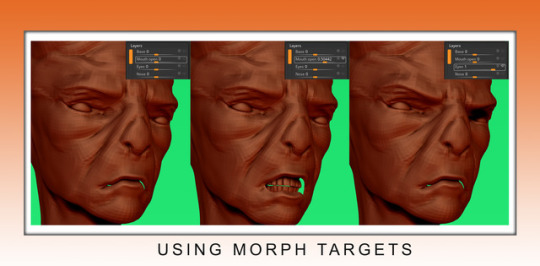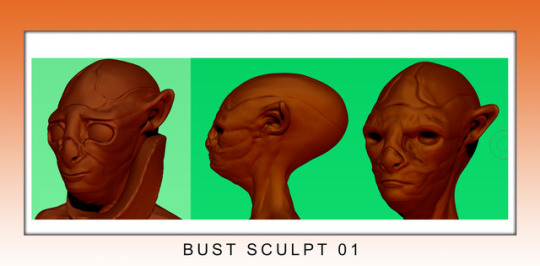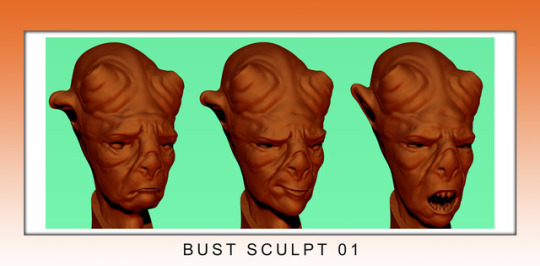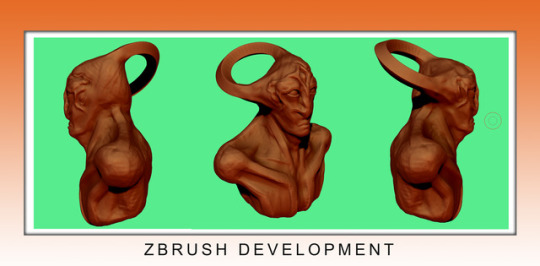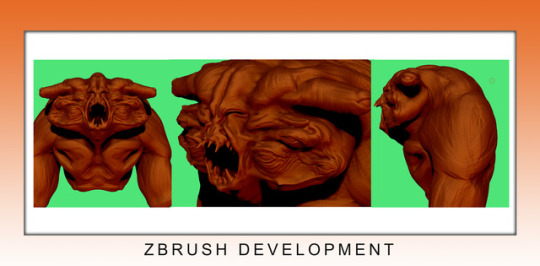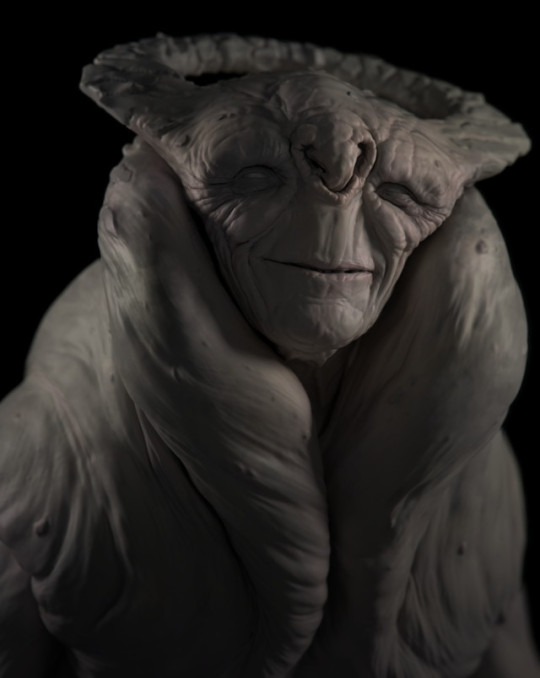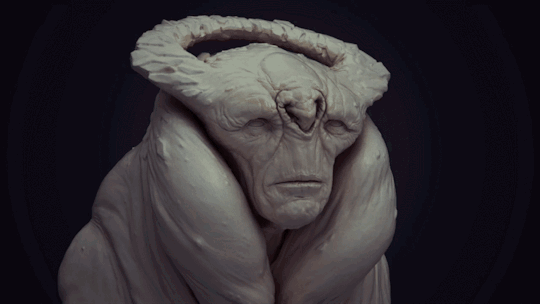Photo
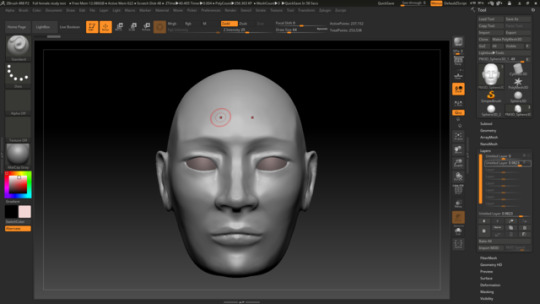
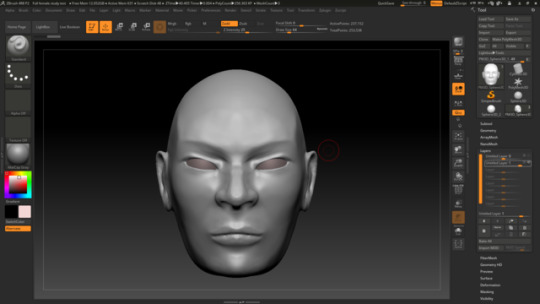
Beginning tests with blendshape layers in Zbrush.
0 notes
Text
Japanese Game Artists -
Are there common themes, approaches and ideas? Is Japanese game art uniquely Japanese? How does it differ from Western game art?
From the several artists that we looked at last week I believe that there are 3 unique focuses across the work. The first of these is the focus on composition and, more specifically, the way in which groups of characters are composed to optimise the viewers experience. With the majority of the work we looked at I noticed that characters within group shots would often be looking at either something unique within the scene or to the side of the viewer adding depth. The second unique focus is the use of colour and contrast. Again referring to the work we viewed last week the understanding and application of colour allows characters and scenes to not only seem real, despite the anime stylisation, but also pop either on screen or page. To further enhance the colour choice a lot of the artwork would include the linework to help define he shape. The third focus that I noticed was the way in which characters are rendered. Common features tend to be wide set eyes. a minimal indication of a nose and mouth and, when compared to Western comics in particular, a more realistic depiction of muscle. Shading also plays a key part in defining characters with heavy emphasis on helping to show muscle and pose.
While Japanese game art may have visual differences when compared to western game art I believe that when it is boiled down to the basic concepts both Western and Eastern art share the same principles and narratives. This is exampled by both Yoshido Akihiko and Yoshitaka Amano and the way in which their work has medieval themes. The renditions of armour like that of Akihiko can be found in games western high fantasy games. Amanos work has very obvious Klimt influences, a European artist.
As with most modern art influences are taken from throughout art history.
2 notes
·
View notes
Text
How has Graffiti influenced video games?
Before taking a look at how graffiti has influenced video games I’m first going to look at what graffiti is.
Simply put graffiti is expressive artwork that is displayed publicly, rather than in a gallery. It is important to understand that there is a difference between the work of graffiti artists and street artists. A graffiti artist creates work typically with the aim to spread their name and speak to other graffiti artists whilst street artists aim to get the public engaged with the artwork. Graffiti artists tend to create stylised typography known as tags sometimes accompanied by cartoon-esque illustrations with the intention to create a name or brand for themselves. Street artists often create work that that may have a political message or even just a deeper concept than graffiti through illustration however this is not to say that graffiti artwork is simplistic. Despite being seen by many as a form of vandalism/crime graffiti and street art have become a common form of self expression and can be found almost everywhere around the world.
There are many games that take heavy influence from the graffiti style such as Marc Ecko’s Getting up: Contents Under Pressure, Bomb the World but the strongest example of a game built around the idea of graffiti is Jet Set Radio in which you control Beat, a member of a rollerblading gang, with the aim to invade rival territory and spread your tag. It takes the concept of a tag being a symbol and applies it to the playable character whilst also playfully adhering to the concept that tagging is based around gang territory which is necessarily the case. Tagging or Bombing is simple about spreading your name to other artists whilst having youthful rebellion connotations.
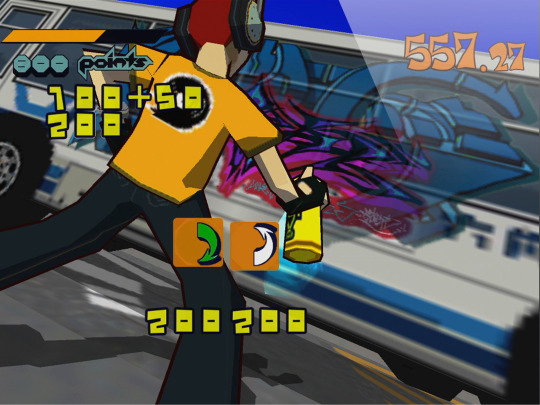
Example of Jet Set Radio gameplay.
With the way that graffiti has become incorporated into modern culture it is a great way to make a virtual environment seem more human. Taking a look at the Grand Theft Auto series graffiti can be found throughout. Not only does this add to the games ‘lived in’ vibe it goes hand in hand with the idea that graffiti and street art are tied heavily to crime. One of the most well known graffiti artists Richard Mirando or Seen worked on throw ups specifically for GTA V.
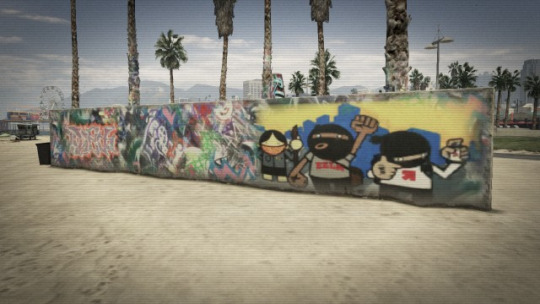
Example of street art/graffiti found within GTA V.
The Grand Theft Auto series features a world based on an existing location, Los Angeles, and has a current day setting however there are many games that are based either in the near future or are variations of places we already know for example Mirrors Edge and Remember Me. Whilst both games are set in dystopic near-future worlds they also use graffiti as a way to add human detail to a fictional environment.

Example of graffiti in Mirrors Edge.
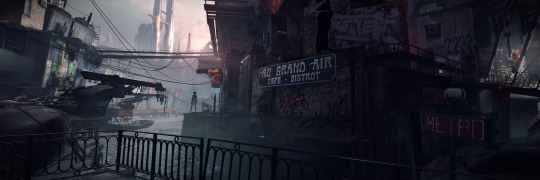
Example of graffiti in Remember Me.
Graffiti can be found in games not only as environmental artwork but also as interactive minigames. (The reason I differ these from the Jet Set Radio example is these are simply a small part of a larger game). Both Infamous: Second Son and Watchdogs 2 allow the player to complete side missions in which they create street art. In both games the use of this street art is to send a message. With Watchdogs 2 the player utilises the overall art style to create street art with the aim to open the game worlds population to the problems with the ‘system.’ Infamous: Second Son utilised stencil street art to create either ‘good or evil’ artwork.


Watchdogs 2 example of street art, before and after.

Example of street art within Infamous: Second Son.
Within Watchdogs 2 the character Sitara uses her artwork as a form of expression and it has traits of street art. The use of contrasting colours, bold lettering and an art style that is both unique and eye catching. This also works great a promotional material for the game as it is a style that is easily shared and spread, much like the concept of graffiti.

In my opinion, and after doing this research, I believe graffiti and street art has a strong influence over both game design and game art. They can be used to further the gameplay or even build a game around the idea of tagging/creating graffiti but most importantly help to create a living environment. Even in a game world like Mirrors Edge which is very minimalistic graffiti brings something more to the world.
0 notes
Text
Bibliography: presentation on A Sunday Afternoon on the Island of La Grande Jatte
(n.d.). Retrieved from http://www.biography.com/people/georges-seurat-9479599#major-works
(n.d.). Retrieved from http://www.thearttribune.com/spip.php?page=docbig&id_document=2786
15 Things You Might Not Know About 'A Sunday on La Grande Jatte - 1884' (n.d.). Retrieved from http://mentalfloss.com/article/63510/15-things-you-might-not-know-about-sunday-la-grande-jatte-1884
2-Minute Masterpiece: Sunday Afternoon on the Island of La Grande Jatte. (n.d.). Retrieved from https://www.youtube.com/watch?v=sQOoDkwxuIs
About This Artwork. (n.d.). Retrieved from http://www.artic.edu/aic/collections/artwork/27992
Famous Paintings of Berthe Morisot. (n.d.). Retrieved from http://www.themasterpiececards.com/famous-paintings-reviewed/bid/63166/Famous-Paintings-of-Berthe-Morisot
Heilbrunn Timeline of Art History. (n.d.). Retrieved from http://www.metmuseum.org/toah/works-of-art/03.30
John Hughes commentary - The Museum scene from Ferris Bueller's Day Off. (n.d.). Retrieved from https://www.youtube.com/watch?v=p89gBjHB2Gs
Louis Leroy (1812-1885) Who first coined the term "Impressionists" (n.d.). Retrieved from http://www.visual-arts-cork.com/critics/louis-leroy.htm
More Famous Paintings of Berthe Morisot. (n.d.). Retrieved from http://www.themasterpiececards.com/famous-paintings-reviewed/bid/63836/More-Famous-Paintings-of-Berthe-Morisot
Pointillism: Seurat's Grande Jatte and Circus. (n.d.). Retrieved from http://www.webexhibits.org/colorart/jatte.html
Summer. (n.d.). Retrieved from http://www.nationalgallery.org.uk/paintings/pierre-cecile-puvis-de-chavannes-summer
The Water-Lily Pond. (n.d.). Retrieved from http://www.nationalgallery.org.uk/paintings/claude-monet-the-water-lily-pond
0 notes
Text
Realism and representational art in video games, bibliography.
(n.d.). Retrieved from http://dictionary.reference.com/browse/aerial-perspective
The 10 Best Selling Video Game Franchises of All Time. (n.d.). Retrieved from http://www.insidermonkey.com/blog/the-10-best-selling-video-game-franchises-of-all-time-331048/7/
15 Best-Selling Video Games Of All Time. (2015, February 13). Retrieved from http://www.techtimes.com/articles/32614/20150213/15-best-selling-video-games-of-all-time.htm
15 Best-Selling Video Games of All Time - IGN Video. (n.d.). Retrieved from http://uk.ign.com/videos/2015/08/28/15-best-selling-video-games-of-all-time
25 Best Selling Video Games Of All Time - Ranked. (n.d.). Retrieved from http://whatculture.com/gaming/25-best-selling-video-games-of-all-time-ranked.php/26
Barnhart, D., & Hindman, K. (n.d.). Retrieved from http://www.wisegeek.com/what-is-representational-art.htm
Blue Poles, 1952 by Jackson Pollock. (n.d.). Retrieved from http://www.jackson-pollock.org/blue-poles.jsp
Chiaroscuro. (n.d.). Retrieved from http://www.visual-arts-cork.com/painting/chiaroscuro.htm
Heilbrunn Timeline of Art History. (n.d.). Retrieved from http://www.metmuseum.org/toah/hd/rlsm/hd_rlsm.htm
Katsushika Hokusai, Ukiyo-e & Edo Period Japan. (n.d.). Retrieved from http://www.hokusaionline.co.uk/code/36_views_mount_fuji.html
Linear Perspective in Painting. (n.d.). Retrieved from http://www.visual-arts-cork.com/painting/linear-perspective.htm
Naturhistorisches Museum. (n.d.). Retrieved from http://www.vienna.cc/deutsch/nhmuseum2.htm
Pace Gallery - Chuck Close. (n.d.). Retrieved from http://www.pacegallery.com/artists/80/chuck-close/exhibitions
Parallax Scrolling: A Simple, Effective Way to Add Depth to a 2D Game - Envato Tuts Game Development Tutorial. (n.d.). Retrieved from http://gamedevelopment.tutsplus.com/tutorials/parallax-scrolling-a-simple-effective-way-to-add-depth-to-a-2d-game--cms-21510
Renaissance. (n.d.). Retrieved from http://www.artmovements.co.uk/renaissance.htm
Renaissance Art. (n.d.). Retrieved from http://www.history.com/topics/renaissance-art
The Easiest Way to Understand Representational Art. (n.d.). Retrieved from http://arthistory.about.com/cs/reference/f/representation.htm
What is Representational Art? (n.d.). Retrieved from http://www.visual-arts-cork.com/representational-art.htm
Heilbrunn Timeline of Art History. (n.d.). Retrieved from http://www.metmuseum.org/toah/hd/ukiy/hd_ukiy.htm
0 notes
Text
Surrealism and video games.
I want to focus on a specific Surrealist ideal. This ideal is all about either mocking what art is or changing how we perceive art and I feel that many game designers are following this ideal today. In a sense surrealism is about innovation. While the visual design of many games today can find their roots within the surrealism movement there are other effects that the movement has had on game design.
One of these effects I believe can be seen in the changing narratives within games. Developers and writers are constantly attempting to create new and unique narratives within games. Over the past few decades as games grow in both popularity and scale we are seeing the introduction of recycled storylines. Be the hero and save the world. I believe that Portal and Spec Ops The Line are great examples of this surrealism innovation. Portal throws you into a unique game world with a mute protagonist. Doing this means the narrative is laid out to the player through contextual clues and other characters. Along with the gameplay, which we all know to be a fresh take upon the FPS genre, creates a game that forces the player to not only change the way they think about the gameplay but also encourages the player to try new things. If we looks at Spec Ops The Line we are again presented with a different approach to storytelling within a genre heavily saturated with recycled storylines. Instead of being a typical save the world shooter the narrative within Spec Ops The Line becomes a harsh view on modern military ethics and the rewards for your actions within the game question the morality of those choices. IGN sums this up perfectly by saying nobody wins in Spec Ops The Line, everything you do hurts somebody, most shooters expect you to save the world, Spec Ops just wants you to save yourself. It’s encouraging to see developers pushing the boundaries of narratives within genres that have becomes tied down with clones claiming to be the next best thing.
Even with narratives changing, the way in which they are presented to the player is crucial. Quantic Dream are a studio that are leading the way when it comes to unique storytelling. Upon its release Heavy Rain became a stand out PS3 exclusive and stapled Quantic Dream as a studio capable of producing incredible narratives through unique gameplay. Beyond Two Souls combines Quantic Dreams unique approach to gameplay with a nightmarish story that allows the player to experience something that many other current games can’t achieve, realism in fiction. What can also be questioned about Quantic Dreams games is are we as the player actually creating our own unique storyline or are we simply following a path that the studio has laid out before us.
Becoming a passive spectator in games is a challenging concept for many players and removing the majority of interaction within a game causes many to question whether it remains a game. Dear Esther and Proteus are great examples of these player limitations however they are at the same time attempting to change the way in which we perceive a game should be made. Both games challenge the idea of gameplay and simply allow the player to explore. I believe Dear Esther and Proteus to be the most surreal games currently available as they mirror the Surreal artists attempt to change what art is.
Surreal art isn’t just about changing perspective on art as a whole it is also about mockery of what art is. Duty Calls is a playable demo released to build interest in Bulletstorm however it is more so a complete mockery of the Call of Duty franchise as you play through a bland, uninspiring environment shooting generic enemies with your generic weapon. It’s a great example of how a game, despite its length, can be a satirical view on the industry as a whole. Stanleys Parable is another great example of satire in games as it mocks the internal voice found in many current games and the idea of interactive storytelling. What is the point of making real decision when the player is controlled by the software they’re using. It can also be argued that Portal has elements of satire as listening to that internal voice of Glados is likely to get you killed.
The role Dali had during the Surrealism movement is another influence that can be seen in modern game design. Dali created a unique persona as he understood how to market himself and create more interest in his work. Today we have many big names in the industry such as Gabe Newell and Notch however I believe the best known name is Phil Fish. Fish is the creator of the game Fez, a unique side scroller, that found its inspiration partly in Myst another surreal game however he is more known for his persona. Like Dali, Fish rose in popularity as he developed Fez however as time passed his persona became warped and he became a hated figure in the industry simply because he was trying to create his perfect game. Despite the large amount of hate he has gathered his game is, in my opinion, one of the best side scrollers to exist and people now love it. The role that the artist or in this case the designer has is crucial to a games success and with the industry growing it’s not unlikely that we will see more rockstar personalities in the industry.
It’s clear to see that surrealism still has a huge influence over the games industry which can be seen in not only the visual design of many games but the way in which we now play them. As the industry moves forward and the rise in 3D and holographics grows the application of surrealism may grow even further as we jump into nightmarish horror games or experience games on a whole new level.
0 notes
Text
How did the Dutch Golden Age art period develop and influence contemporary video games.
The Dutch Golden Age saw huge turmoil surrounding both political powers and the religious powers with William of Orange leading a rebellion against the state, similar to the general storyline of star wars. As King Phillip of Spain reigned with an iron fist, the use of extreme tortures and attitude towards the protestant beliefs caused William to bring in the help of the sea-beggars, a group of tough pirates. Eventually after many battles, the assassination of William and an eventual peace treaty the Netherlands is reborn as a wealthy and strong state. I believe that the events of the time shaped artists into creating more realistic depictions of their subjects in an attempt to truly convey emotion and relatability.
Age of Empires III features this reborn state excellently with the Dutch being a playable class. Visually the game features the various architectural tropes as well as unique technologies such as Religious Freedom; allowing the player to create more banks and import unique troops. Trading and import is a huge part of Age of Empires and reflects the fact that towards the end of the Dutch Golden Age the Dutch East India trade gained traction, eventually becoming one of the main trade companies in the 1600s.
With naval trade and battle being a huge part of the Dutch Golden Age marine painting surfaced as not only a way to record the events of the time but to also push their artistic skills in a new direction focusing on capturing the dynamic action of ships on water. We all know that the assassin creed games span history and have featured naval combat in the fourth iteration of the series Black Flag. The work of Hendrick Vroom captures the true nature of ships on water, the men on board and the scale of the ships and when we look at the gameplay of Black Flag we can see this appreciation of natures power and a realistic depiction of naval warfare. Depicting the movement of water and how the ships would have worked against this is a difficult thing to achieve yet both the game and the artist are able to place us within the scenes. We also see on the protagonists ship the various crewmen working to keep you moving and alive, again Vroom also details this in his work showing the men on the ships furiously rowing to keep their ships moving. Whilst Vrooms work may not have directly influenced Black Flag we can see that throughout time naval warfare and the depiction of marine art is beautiful when done correctly.
As we look at the work of the Dutch Golden Age’s most popular artist Remembrant, we again see the attempt to focus on realism. Looking at his portrait work we can see an incredible attention to detail and an expert use of light. This combination helps to convey a true emotional appreciation of the subject and allows a stronger connection between the subject and the viewer.
This can be reflected in character creation segments of many games which, at a stretch, put you in the seat of Remembrant. As the creator you are attempting to build something that you relate to and is more than just a standard character. As we can see in both Metal Gear Solid V and Dragon Age Inquisition the focus on realism is evident along with the use of near perfect lighting that allows you to create your perfect character.
As we continue to look at Dragon Age Inquisition we can see that there are more references to not only Remembrant’s work but also the Dutch Golden Age. The main reference is extremely obvious in that the game revolves around the struggle between two powers which is something that also occurred during the Dutch Golden Age. Within the period the conflict between protestants and Catholics reached a brutal climax with many deaths on both sides and within Dragon Age Inquisition we see two major powers clashing, the templars and mages.
The art of Dragon Age Inquisition is highly stylised but similarities can be seen between it and that of Remembrant. If we look at some more of his work we can see that the use of light allows him to create importance within the piece. If we then look at the tarot cards of Dragon Age Inquisition this use of light is also used to suggest importance within the small scenes. It’s also worth mentioning that while the scenes within the tarot cards feature fantasy creatures the way in which they’re painted reflects Remembrants use of realism and ability to create emotion.
Throughout the game and its many cinematics we are presented with scenes featuring many of the key characters. Remembrants also focused a lot on depicting full scenes with multiple characters all of which tell a unique story. If we look at his piece Balshazars feast we can see an incredible amount of visual detail, not only in the clothing of the characters but within each characters face. They all appear to be looking at something unique, and in many of the cinematics within Dragon Age the character are often focused on something unique also. The detail of each characters clothing can also be seen exampled in Dragon Age as well as the use of invisible table light to help create importance without ruining the overall composition of the scene.
As with the previous periods we’ve looked at, I believe that contemporary game design doesn’t take direct influence from the Dutch Golden Age however it is more so a subconscious understanding that has been conveyed throughout the centuries. If artists are looking at creating a game with the Dutch Golden Age in mind the amount of work available and quality of it is vast and varied. The understanding and appreciation of light, the use of direction within the composition and the appreciation of realism to create a relatable piece of art are what many artists today use in their designs.
0 notes
Text
Edo Period – Zen Principles applied to Japanese art, minimalism and contemporary video games.
As was discussed in the previous lesson, the Zen principles had an important role in the development of art during the Edo Period. The principles can be generalised into the focus of achieving the perfect artwork through honesty, simplicity and mystery. The principles are initially applied to Chinese artwork through the use of limited mark making and an unconventional composition, allowing the viewer their own unique interpretation and experience of the artwork. Examples of this can be seen in Wang Fu’s Boatmen on a River with Distant Mountains. Despite being a complete composition the piece features very little detail and sticks to the principles of Zen. We can see an honest depiction of the boatman surrounded by the vastness of nature. Due to the use of a single colour the piece also conveys tranquillity and suggests that Fu would have been at peace while creating this artwork.
As trade continued between China and Japan we see these principles begin to make their way into Japanese art during the Edo period. Some artists use these principles consciously but it’s highly possible that it subconsciously influences many artists during the period also. If we look at the work of Kano Eitoku and his folding panel screen ‘Birds and Flowers of the Four Seasons’ we can see some of the principles being applied. While there is more detail, the simplicity of his linework creates an idyllic and uncluttered landscape. It’s worth mentioning that the name of this piece, which by itself creates an image in your mind of peace and calm, goes hand in hand with the landscape reminding the viewer of a spiritual appreciation of life and nature. The application of the principles during the Edo period allowed artists of the time to convey their appreciation of the world around them, the subjects within their paintings and also develop themselves not only as an artist but as a spiritual person.
As we begin to look forward the influence the Edo period had over many contemporary art fields becomes very clear. Minimalism can find it roots within Edo period and the Zen principles. Whilst minimalism is subjective to the individual it carries principles similar to Zen; an appreciation of open space, simplicity through the most basic shapes, structures and marks and detail through seemingly nothing. Ulrich Ruckriem, an artist in the minimalist field, created many sculptures that combined the use of basic shapes and natural canvases to create work that appeared uncluttered, simple and almost spontaneous. These sculptures aim to represent art and nature in their simplest forms, much like the artists of the Edo Period.
Whilst game designers today may not sit down and underline how to use the Zen principles, the ideals apply almost subconsciously. ‘Journey’ is great example of these ideals applied and each principle can be exampled. Asymmetry: the unconventional design of the game allows for the creation of something far better than others, as with Japanese artists attempting to create the perfect piece. Simplicity: ‘Journey’ provides one main mission, reach the top of the presented mountain. This maintains an uncluttered mind and allows the player to create their own unique journey. Astringency: the nameless character that the player uses isn’t a 6 foot hero, it is simply a creature you use to progress through the game, which in turn lets the player create the story and character for them, beauty through use. Naturalness: players can choose whether they work with others or stay solo. This creates both an honesty with other players and avoids the feeling of being forced along a path that many other games do. Profundity: no one wants to have the entire game spoilt at the beginning and ‘Journey’ does a great job of slowly revealing more details to the player through different environments and puzzles. This also helps the player push their skill level allowing them to better themselves as a gamer just as the Japanese artists would attempt to push themselves as artists through their work. Non-attachment: the balance of ambition is a difficult principle to both understand and apply. Journey is able to do this by encouraging the player to continue but almost punishes the players progression through the inclusion of danger and enemies. Tranquility: the most obvious principle portrayed in Journey, it is show through the player being able to meditate at the end of a level. This not only allows for a pause within the game but allows the player to reflect on the previous level and look forward to what comes next.
Each principles application with Journey makes the game what it is, a Journey. With it being recognised as one of the most beautiful and simple game of the current generation and proving that the video game industry can be seen as an art form, it further pushes the idea that the application of the Zen principles can create beauty where many think there is none.
0 notes

